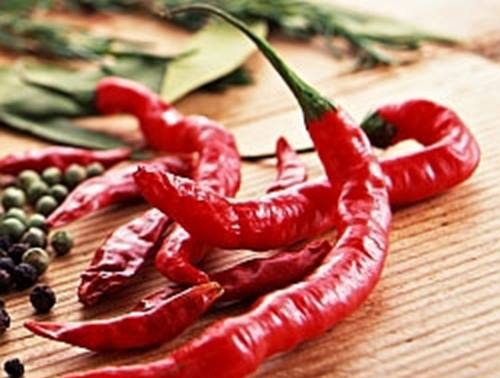 Experienced active gardeners will always find a place to grow something new and unusual. This also applies to the cultivation of red capsicum, which differs not only in the shape of the fruit and the characteristics of the cultivation, but also in a special spicy taste, on which the possibilities for its further use depend.
Experienced active gardeners will always find a place to grow something new and unusual. This also applies to the cultivation of red capsicum, which differs not only in the shape of the fruit and the characteristics of the cultivation, but also in a special spicy taste, on which the possibilities for its further use depend.
Content
Description and characteristic
Capsicum belongs to the category of nightshade crops, which means that most of the attention should be paid to the development of a strong root system, sufficient looseness of the soil and timely watering. The plant is thermophilic, therefore, the optimum air temperature for its successful growth should be in the range of 18 - 25 degrees Celsius. In this case, it is necessary to observe the full hydration of fertile soils and periodically feed the roots. It is this variety of peppers that is most suitable for growing in flowerpots on the windowsills of apartments and balconies. This is due to the small height and compactness of the bushes.
The name "leguminous" characterizes the shape of ripening fruits, which differ in fleshy soft walls without much crunching. It is customary to divide the entire category of red chillies into groups depending on the degree of severity, shape and possibilities for further use of the harvested crop.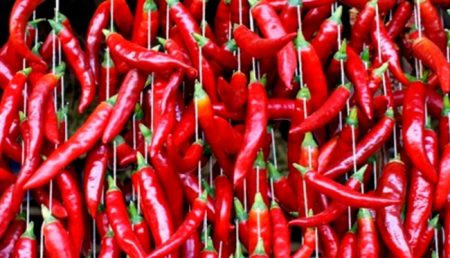
Benefit
The usefulness of the use of capsicum is, first of all, in the beneficial vitamins and microelements available in their composition. This primarily concerns proteins and healthy sugars, high levels of vitamins C, P and group B, as well as carotene, essential oils and flavonoids. It is not necessary to ignore the saturation of the pulp with such useful mineral components as iron, zinc, phosphorus, calcium, potassium and copper.
It is important to consider that some varieties of hot red pepper are so burning that serious irritation can be obtained even by touching its fruits. When using this type of peppers in cooking, for example, for cooking stews or fried dishes, rubber gloves should be stocked. In addition to the fresh look, chilli can be dried, frozen, canned or used as an ingredient in spicy seasonings for future tasty dishes. Peppers are particularly acute due to the presence of capsaicin in them, which also provokes the strengthening of the body's immunity against various viral and infectious diseases.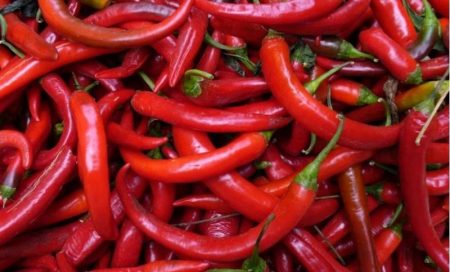
The use of pepper in the diet is not recommended for people with diseases of the kidneys, stomach and duodenum. The acute fetus is also contraindicated in diseases of hepatitis, hemorrhoids, pancreatitis and hyperacid gastritis.
Varieties of red chilli peppers
In the selection of suitable varieties of red hot pepper, it is worth considering the optimal conditions for their cultivation, as well as the need to grow in greenhouse conditions or on open ground. One of the peculiarities of growing hot pepper bushes concerns growing it far from other nightshade crops, since the unsuccessful pollination of flowers can lead to the fact that the fruits of other plants will become bitter in taste. This is especially true for sweet pepper bushes and various varieties of tomatoes.
Jellyfish
The variety belongs to the category of early ripening plants, since the ripening of fruits occurs already on 72 days from the moment of the appearance of the first seedlings sprouts. An important advantage of the variety is the small height and compactness of the bushes themselves, which germinate no more than 30 - 32 cm and occupy about 20 - 22 cm in diameter. Thanks to this, each individual plant can be grown in ordinary pots on window sills. With this method of cultivation, it is worthwhile to take care of sufficient lighting in the room and pepper bushes in particular.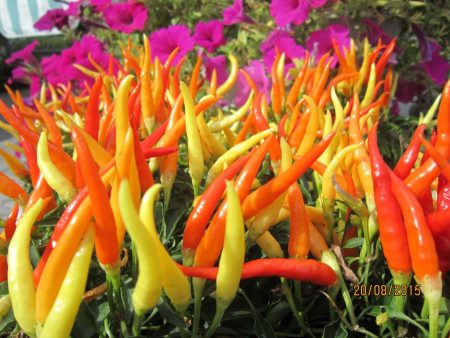
The variety is characterized by increased productivity, since from each individual plant you can get at least 30 - 45 sharp leguminous fruits. The shape of peppers is long and thin. Peppers can reach 5.5 cm in length, and in diameter they will be only 1 - 1.5 cm. During the ripening period, the fruits change color several times: initially, green peppers first turn yellow and orange, and then, at the time of full biological maturity, acquire a rich red color.
One of the prerequisites for growing a variety concerns regular and at the same time moderate soil moisture, as well as compliance with optimal air humidity. That is why the bushes must not only be watered with warm water under the root, but also sprayed with moisture using a spray gun.
Twinkle
The demand for the variety among experienced gardeners is determined by the ability to grow it, both on open ground and on window sills in small pots. An important feature of pepper is its long-term fruiting and mid-early period of full ripening. The variety is the result of crossing cayenne and Chilean pepper species. Due to this, the fruits are particularly hot. In this case, the technical maturity of the fruit occurs within 120 days from the first seedling emergence. Biological maturation occurs after another 20 days. In the first case, the fruits are distinguished by a saturated green color, which gradually changes to bright red.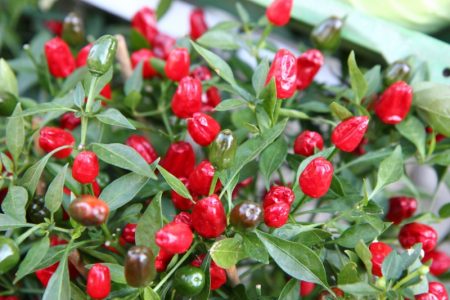
Grown fruits are lightweight, about 40 g and elongated with a slight bend shape. The pulp is characterized by a characteristic pepper aroma with sufficient sharpness. When growing bushes are resistant to possible damage to bacteriosis. Since the variety is extremely thermophilic, it is recommended to grow it in protected greenhouse conditions. An exception may be only open soils of the southern regions with a predominantly warm climate.
Indian summer
The name of the variety is due to the fact that the full ripening of bright red fruits with an acute taste falls on the month of September. The growing season takes about 100 days, and it is recommended to grow peppers in protected greenhouse conditions. In the presence of a warm climate characteristic of the southern regions, plants can be grown on open ground. However, they are extremely difficult to tolerate unexpected cooling.
The bushes themselves are compact in size, since their height does not exceed 40 cm, and the stems are covered with numerous small dark green leaves. A feature of the variety is that the fruits are formed singly or in pairs in the axils of the leaves. Fruits also differ in small sizes. Their weight does not exceed 25 g, so at the time of biological ripening gardeners receive small decorative bushes, abundantly strewn with bright red fruits-berries.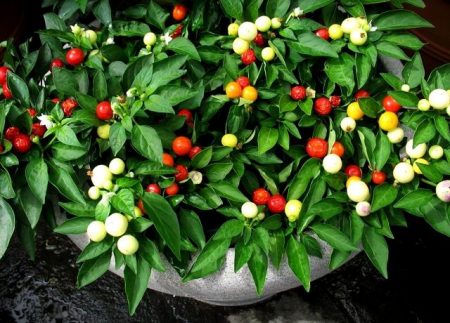
The yield of the variety is characterized as quite high, since about 0.9 - 1.2 kg of the crop can be harvested from one grown bush. An important advantage of the variety is its shade tolerance and resistance to various viral diseases.
Adjika
The hot pepper variety has good taste and is suitable for cultivation on open ground. In this case, the plant belongs to the category of medium early and is widely used in modern cooking.The bushes grow tall enough, but a powerful stem does not need to be tied to an additional support.
The average weight of the fruit is about 90 g. At the stage of biological maturity, peppers with an elongated-conical shape are distinguished by the dark red color of the peel and sharp flesh with a sharp taste. As a rule, the grown crop is used as a spicy seasoning for soups, sauces, meat dishes, as well as in the conservation process.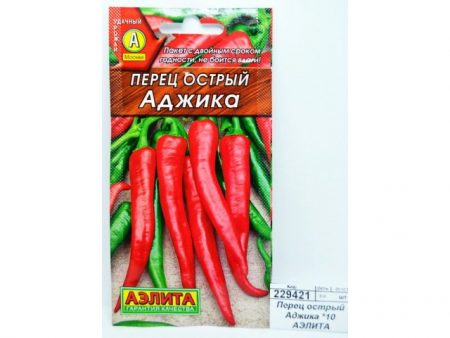
Of the features of growing pepper, it should be noted that loamy loose soils that pass oxygen well are most suitable for it. In this case, the seeds themselves must first be treated with a light pink solution of potassium permanganate (20 - 25 minutes), then washed with clean running water and only then planted in the ground. The first picking of plants is allowed only after the formation of 2 - 3 full leaves. Planting bushes should be carried out at a distance of 30 - 35 cm.
Hungarian yellow
The variety belongs to the category of early ripening plants and has a milder taste, which is simultaneously characterized as juicy and sweet-spicy. Bushes grow only up to 25 cm in height. Thanks to this, they are successfully grown not only in open fields or in protected greenhouses, but also in pots for flowerpots placed on the windowsill.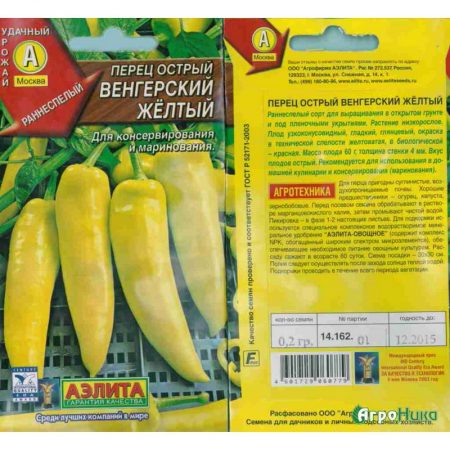
The shape of the fruit is conical with a drooping position. Peppers acquire a yellow color at the stage of technical ripening, but already with full biological readiness, it becomes bright red. The average weight of the fruit is about 55-60 g. The surface of the peel is glossy. Peppers are used, as a rule, as a hot seasoning for dishes and preserves for the winter.
For mother-in-law
The pepper variety belongs to the category of early ripening plants. The fruits are distinguished by a strong odor and a rather spicy pungent taste, as well as a bright red color and a conical shape. Among the important advantages of the variety, it is also worth highlighting the high productivity of the cultivated bushes and the widespread use of the fruits themselves in modern cooking.
Pepper is suitable for cultivation in open fields. The height of the bushes, as a rule, does not exceed 60 cm. The plant does not need pinching and tying to additional supports. A full vegetation period lasts about 110 - 120 days from the moment the first seedlings emerge. At the same time, the peppers themselves have a length of about 10 - 12 cm.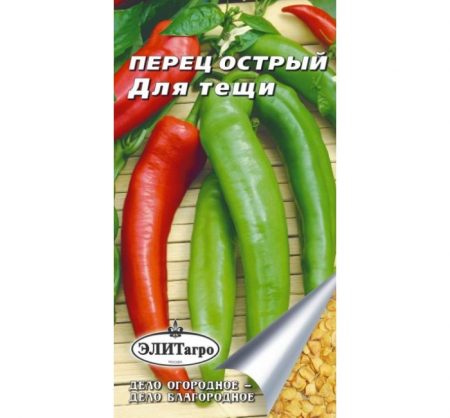
For successful cultivation of varieties, it is better to choose loamy breathable soils and air temperature in the range of 20 - 25 degrees Celsius. The first transplantation of grown seedlings is allowed only after the appearance of 2 - 3 full leaves on the stems. Like most other nightshade crops, the variety needs regular soil moisture and several essential soil fertilizers with mineral or organic complexes. You can plant pepper on open ground only after the risk of returning spring night frosts has passed.
The grown fruits ripen together, and resistance to possible mechanical damage allows you to grow a variety for the purpose of further sale, and not just for your own use.
Coral
The main difference between the variety lies in the special pungency of its taste, as well as the high yield of each planted bush. The variety belongs to the category of medium early plants and is often used as a decorative decoration in a cozy home kitchen. It is possible to grow, both in greenhouse conditions, and on open grounds.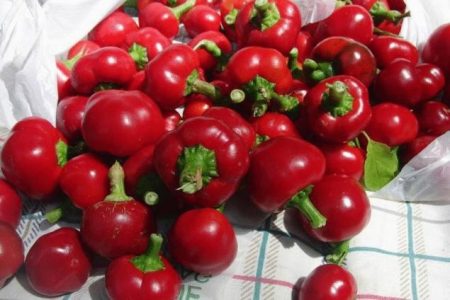
The bushes grow to a height of 40-60 cm. Moreover, the fruits themselves are rounded with a diameter of up to 2-3 cm. The taste of the fruit remains invariably sharp and even burning. At the time of biological maturation, peppers acquire a rich red color.When planting bushes in a common ground, keep a distance between holes of at least 40 - 50 cm or not more than 5 - 6 plants per 1 sq. M area.
Fiery bouquet
The variety is early ripe, and to the taste of the fruit it is distinguished by special stinginess and spiciness. Due to its taste, it is widely used in modern cooking. The variety is one of the few representatives of hot peppers, the bushes of which sprout yes 100 - 120 cm and are considered indeterminate.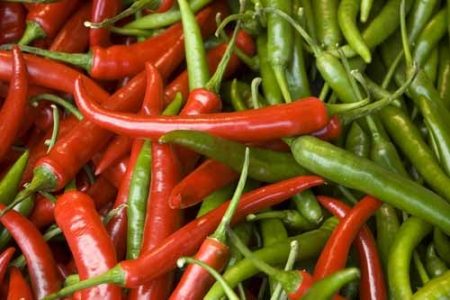
The fruits themselves have an elongated conical shape and an average weight of about 19 - 20 g. During ripening, the saturated dark green color changes to bright red. As a rule, the crop is used for the manufacture of spicy spices or as an ingredient in canning for the winter.
Superchill
The demand for the hybrid among experienced gardeners is due to the ability to obtain fruits with a very sharp taste and large size. At the same time, pepper is distinguished by increased productivity and belongs to the category of early ripe nightshade crops.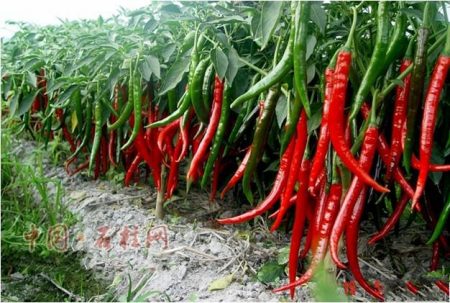
Bushes grow up to 40-60 cm, and fruits can be obtained up to 6-7 cm long and with an average weight of about 15-25 g. The process of full ripening of fruits lasts about 65-70 days from the moment of transplanting the seedlings to a constant place of growth. The color of the peel on ripe fruits is characterized as cherry red, while at the stage of technical ripening it changes from green to orange. The only rule for growing a hybrid is the lack of proximity to other varieties of peppers, especially sweet peppers, because unsuccessful pollination can be manifested by the altered taste of the grown peppers.
Jalapeno
The variety is most in demand among experienced gardeners, due to its moderate degree of severity of taste, as well as the ability to grow for the purpose of further sale. Bushes sprout up to 1 m tall and are characterized by abundant fruiting, but the plant simply discards most of the flowers.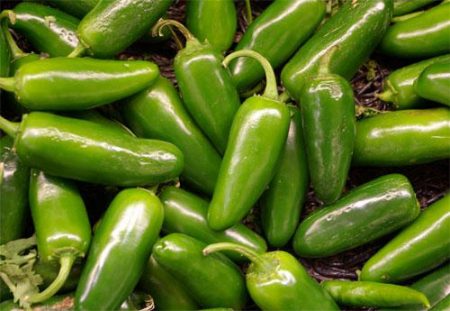
The fruits grown differ in length by about 7 - 8 cm and in diameter up to 2.5 - 3 cm. In addition, each pepper weighs about 50 g. The color of the fruit remains dark green at the stage of technical maturity, it turns into dark red. Since the taste of pepper is characterized as medium spicy, the fruits are often used in the preparation of salads and hot dishes. The richness of the thick pulp is unique to hot pepper varieties.
Dragon tongue
The main feature of the variety is the very strong burning taste of the fruits themselves. It is these fruits that are most often used for making paprika. It is recommended to grow in closed protected greenhouses.
The variety belongs to the category of mid-ripening plants. At the same time, the fruits themselves take the form of a thin long pod with bright red color at the stage of biological maturity. The length of the fruit is about 10 - 12 cm, and in diameter they grow to 8 - 10 mm. The average weight of peppers is 14-18 g.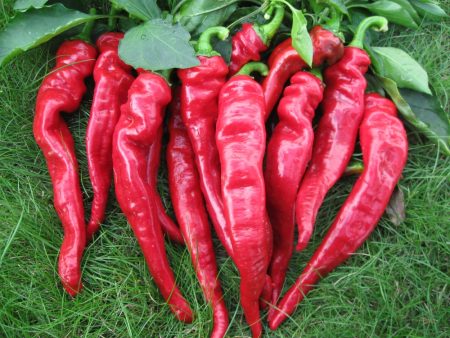
Due to the high yield of the variety, as a result, you can get about 90 - 100 full-fledged fruits. In addition to use for making paprika, the variety is successfully used in sauces, various pastas, as well as in canning and pickles.
Rules for growing red capsicum
The main difference between the varieties of red hot pepper is the ability to grow them not only in greenhouses, but also in flowerpots on window sills. At the same time, it is extremely important to ensure that the bushes are in well-lit, but not accessible to children and pets. Varieties are unpretentious to the composition of the soil and many of them patiently grow in shaded places, but at the same time require regular and always moderate watering.
The optimum soil for pepper cultivation is a mixture of humus, peat, garden or leaf land and sand in a proportional ratio of 1: 2: 1: 2.before full use, the soil must be thoroughly decontaminated with ordinary boiling water or a boiling bright pink solution of potassium permanganate. At the bottom of the container 1/3 drainage is laid out first, and then already prepared and treated soil. The lower layer will absorb excess moisture, which effectively prevents unwanted stagnation of water in the soil and damage to the root system of the seedlings.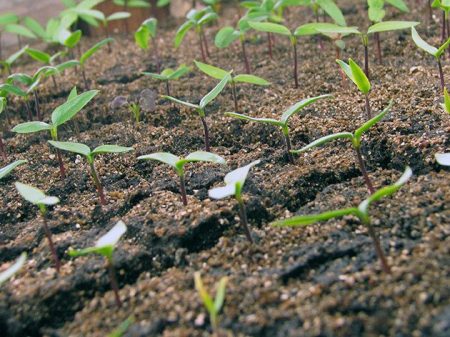
Of the mandatory requirements for the care of plants should be highlighted:
- regularity of irrigation with warm settled water with a temperature of at least 26 - 30 degrees after the top layer begins to dry;
- fertilizing soils using mineral or organic fertilizers especially at the time of flowering of bushes and the formation of ovaries of future fruits.
Seeds can be sown to a depth of not more than 1 - 1.5 cm. Moreover, containers with soil and seedlings should be in bright rooms with a temperature regime of about 25 - 27 degrees Celsius. Varieties of hot peppers are extremely sensitive to picks and transplants, so if possible, the seeds should be sown immediately in separate small containers, as a rule, special peat pots are used for this.
Reviews
Andrei Ivanovich, 39 years old
One of the most dangerous mistakes in caring for hot pepper bushes concerns over-watering the soil using cold water, since this procedure can trigger the onset of rotting of the root systems of the bushes, and hence the loss of the expected yield. The optimal irrigation regime is characterized as 2 times a week, but if pepper is grown on the windowsill, under which there is an included heating system, the irrigation regime should be divided up to one irrigation every other day, because under such conditions the soil dries faster.
Vladislav Anatolyevich, 54 years old
Due to the taste characteristics of peppers, they remain resistant to most diseases. This is especially true for ticks and aphids, which can fly into the balcony from the street or "live" in other neighboring plants. Pepper in this case is an effective deterrent for them. To prevent pepper damage with a spider mite, avoid too dry air in the room and a long absence of watering. As a treatment, it is better to spray with a soda solution (250 g per 7 - 8 liters of water) using a spray gun. Such processing is recommended to be carried out twice with a mandatory weekly break.




 Calorie pepper stuffed with meat and rice - BZHU per 100 grams
Calorie pepper stuffed with meat and rice - BZHU per 100 grams Gorky pepper - the best varieties for open ground
Gorky pepper - the best varieties for open ground Hot pepper seeds - the best varieties for open ground and reviews
Hot pepper seeds - the best varieties for open ground and reviews Capsicum tincture for hair - how to use and reviews
Capsicum tincture for hair - how to use and reviews